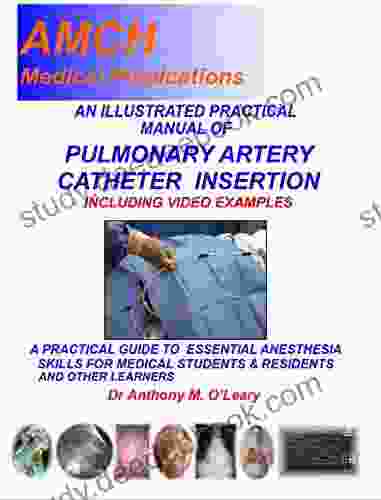Pulmonary Artery Catheter Insertion: A Comprehensive Guide for Healthcare Professionals

Pulmonary artery catheter insertion (PACI) is an invasive procedure used to measure pressures and oxygen levels in the pulmonary artery. This information can be used to assess cardiac function, fluid status, and gas exchange. PACI is typically performed in critically ill patients who require hemodynamic monitoring, such as those with sepsis, shock, or respiratory failure.
4 out of 5
| Language | : | English |
| File size | : | 31008 KB |
| Screen Reader | : | Supported |
| Print length | : | 121 pages |
| Lending | : | Enabled |
| Paperback | : | 152 pages |
| Item Weight | : | 1.74 pounds |
| Hardcover | : | 436 pages |
Indications
The following are the most common indications for PACI:
* Hemodynamic instability * Sepsis * Shock * Respiratory failure * Cardiac arrhythmias * Pulmonary hypertension * Fluid overload * Evaluation of cardiac function * Titration of vasopressors and inotropes
Contraindications
PACI is contraindicated in patients with the following conditions:
* Severe thrombocytopenia (platelet count 1.5) * Active endocarditis * Uncontrolled arrhythmia * Severe pulmonary hypertension * Recent myocardial infarction * Unstable angina
Risks and Benefits
PACI is a relatively safe procedure, but it is not without risks. The most common complications include:
* Bleeding * Infection * Arrhythmias * Air embolism * Pulmonary embolism * Catheter-related thrombosis * Hemolysis
The benefits of PACI outweigh the risks in most cases. Hemodynamic monitoring can help to optimize fluid and vasopressor therapy, which can improve patient outcomes. PACI can also be used to guide ventilator settings and to assess the response to therapy.
Technique
PACI is typically performed in the intensive care unit (ICU) by a critical care physician or nurse. The patient is placed in a supine position and the insertion site is prepared. The most common insertion site is the internal jugular vein, but the femoral vein or subclavian vein may also be used.
A small incision is made in the skin and a dilator is inserted into the vein. The dilator is then removed and the pulmonary artery catheter is inserted over a guidewire. The catheter is advanced through the right atrium, right ventricle, and pulmonary artery until it is positioned in the pulmonary artery wedge position.
The pulmonary artery wedge position is confirmed by visualizing the characteristic wedge-shaped pressure waveform on the monitor. Once the catheter is in place, the pressures and oxygen levels in the pulmonary artery can be measured.
Complications
The complications of PACI can be divided into two categories: early complications and late complications. Early complications occur within 24 hours of catheter insertion, while late complications occur after 24 hours.
Early complications
* Bleeding * Infection * Arrhythmias * Air embolism * Pulmonary embolism
Late complications
* Catheter-related thrombosis * Hemolysis * Catheter migration
Management of Complications
The management of PACI complications depends on the severity of the complication. Minor complications, such as bleeding or infection, can be treated with conservative measures. More serious complications, such as air embolism or pulmonary embolism, require immediate medical intervention.
PACI is a valuable tool for the hemodynamic monitoring of critically ill patients. It is a relatively safe procedure, but it is not without risks. Healthcare professionals should be familiar with the indications, contraindications, risks, benefits, technique, and complications of PACI before performing the procedure.
4 out of 5
| Language | : | English |
| File size | : | 31008 KB |
| Screen Reader | : | Supported |
| Print length | : | 121 pages |
| Lending | : | Enabled |
| Paperback | : | 152 pages |
| Item Weight | : | 1.74 pounds |
| Hardcover | : | 436 pages |
Do you want to contribute by writing guest posts on this blog?
Please contact us and send us a resume of previous articles that you have written.
 Book
Book Page
Page Chapter
Chapter Text
Text Story
Story Newspaper
Newspaper Paragraph
Paragraph Sentence
Sentence Shelf
Shelf Glossary
Glossary Foreword
Foreword Preface
Preface Manuscript
Manuscript Scroll
Scroll Codex
Codex Tome
Tome Classics
Classics Biography
Biography Autobiography
Autobiography Encyclopedia
Encyclopedia Dictionary
Dictionary Character
Character Librarian
Librarian Catalog
Catalog Card Catalog
Card Catalog Stacks
Stacks Archives
Archives Study
Study Research
Research Lending
Lending Journals
Journals Reading Room
Reading Room Rare Books
Rare Books Literacy
Literacy Thesis
Thesis Awards
Awards Reading List
Reading List Book Club
Book Club Theory
Theory Textbooks
Textbooks Andrew S Erickson
Andrew S Erickson Muhammad Yunus
Muhammad Yunus Eric J Wittenberg
Eric J Wittenberg Greg Cohen
Greg Cohen Michelle Celmer
Michelle Celmer Michael Fordham
Michael Fordham Muriel Barbier
Muriel Barbier Hal Leonard
Hal Leonard David Delevante
David Delevante Dermot Meagher
Dermot Meagher Marcus Gray
Marcus Gray Beverly Bell
Beverly Bell Marion Nestle
Marion Nestle Zadeh Publishing
Zadeh Publishing Gary B Nash
Gary B Nash Erika Parker Price
Erika Parker Price Pamela H Mackellar
Pamela H Mackellar Philip Wu
Philip Wu Patrick Warfield
Patrick Warfield Victoria Ong
Victoria Ong
Light bulbAdvertise smarter! Our strategic ad space ensures maximum exposure. Reserve your spot today!

 Jean BlairMastering Microsoft PowerPoint 2024: A Comprehensive Guide for Beginners and...
Jean BlairMastering Microsoft PowerPoint 2024: A Comprehensive Guide for Beginners and...
 Mark TwainTeenage Odyssey in 1980s Los Angeles: A Journey of Self-Discovery, Rebellion,...
Mark TwainTeenage Odyssey in 1980s Los Angeles: A Journey of Self-Discovery, Rebellion,... Ken SimmonsFollow ·3.8k
Ken SimmonsFollow ·3.8k Colin FosterFollow ·9.5k
Colin FosterFollow ·9.5k Julio Ramón RibeyroFollow ·8.5k
Julio Ramón RibeyroFollow ·8.5k Jake CarterFollow ·10.3k
Jake CarterFollow ·10.3k Timothy WardFollow ·10.3k
Timothy WardFollow ·10.3k Joshua ReedFollow ·17.4k
Joshua ReedFollow ·17.4k Dominic SimmonsFollow ·6.3k
Dominic SimmonsFollow ·6.3k Arthur C. ClarkeFollow ·12.1k
Arthur C. ClarkeFollow ·12.1k

 Dominic Simmons
Dominic SimmonsIcky Island: An Unforgettable Adventure for Kids!
Introducing Icky Island: A Delightful One...

 Carlos Fuentes
Carlos FuentesThe Midnight Breed: Embracing the Shadows and Unlocking a...
Welcome to the captivating world of...

 Ike Bell
Ike BellTwelve Steps Toward Political Revelation: A Path to...
Politics, often perceived as a complex and...

 Cameron Reed
Cameron ReedTravels in Arizona Goldfield: Unraveling the Threads of...
Nestled amidst the rugged...

 John Grisham
John GrishamFlashpoints of Cinema History and Queer Politics:...
The relationship between cinema history and...
4 out of 5
| Language | : | English |
| File size | : | 31008 KB |
| Screen Reader | : | Supported |
| Print length | : | 121 pages |
| Lending | : | Enabled |
| Paperback | : | 152 pages |
| Item Weight | : | 1.74 pounds |
| Hardcover | : | 436 pages |










